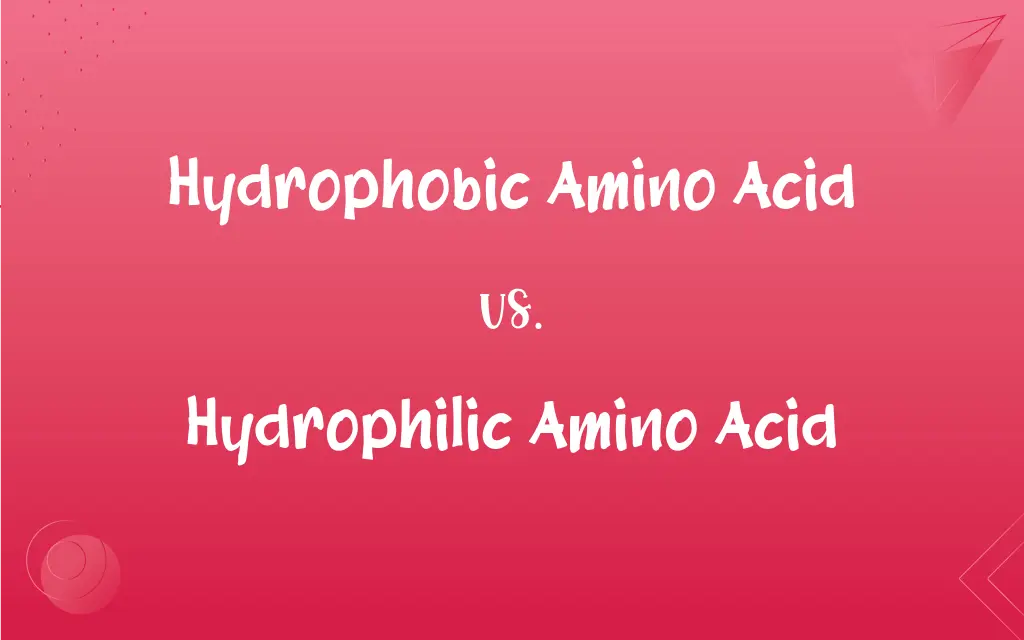Hydrophobic Amino Acid vs. Hydrophilic Amino Acid: What's the Difference?
Edited by Aimie Carlson || By Janet White || Published on February 26, 2024
Hydrophobic amino acids repel water, often found in protein interiors; hydrophilic amino acids attract water, usually located on protein surfaces.

Key Differences
Hydrophobic amino acids have nonpolar side chains that repel water, making them less soluble in aqueous environments. They typically cluster inside proteins, away from water. On the other hand, hydrophilic amino acids have polar or charged side chains that can form hydrogen bonds with water, making them more soluble and often found on the exterior surfaces of proteins.
In protein structure, hydrophobic amino acids play a crucial role in stabilizing the core of proteins, helping to maintain their 3D structure. Contrastingly, hydrophilic amino acids are often involved in interactions with the aqueous environment, including binding to water and other polar molecules, crucial for protein's function and stability on the surface.
The side chains of hydrophobic amino acids like leucine, valine, and phenylalanine are made up of carbon and hydrogen atoms, contributing to their water-repellent nature. In contrast, the side chains of hydrophilic amino acids like serine, threonine, and lysine contain groups like hydroxyl (-OH) or amine (-NH2), which attract water molecules.
Hydrophobic amino acids are often involved in the formation of hydrophobic interactions, which are vital for the folding and stability of proteins. Hydrophilic amino acids, however, are key players in forming active sites of enzymes, receptor sites, and ion channels due to their ability to interact with water and other polar substances.
The distribution of hydrophobic amino acids within a protein influences its location within cells, often in membranes or within the cytoplasm. Hydrophilic amino acids are more likely to be found in proteins that are exposed to the cellular or extracellular environment, participating in interactions with other molecules.
ADVERTISEMENT
Comparison Chart
Solubility in Water
Low solubility, repels water
High solubility, attracts water
Side Chain Composition
Nonpolar, mostly carbon and hydrogen
Polar or charged, contains oxygen or nitrogen
Role in Proteins
Stabilize protein interior
Interact on protein surfaces
Common Examples
Leucine, Valine, Phenylalanine
Serine, Threonine, Lysine
Biological Function
Support protein structure, hydrophobic interactions
Form active sites, receptor sites, ion channels
ADVERTISEMENT
Hydrophobic Amino Acid and Hydrophilic Amino Acid Definitions
Hydrophobic Amino Acid
Amino acid less likely to interact with water molecules.
The hydrophobic amino acids in the protein help form its core structure.
Hydrophilic Amino Acid
Soluble amino acid due to its polar nature.
Serine, a hydrophilic amino acid, is involved in many metabolic processes.
Hydrophobic Amino Acid
Key component in stabilizing the internal structure of proteins.
Hydrophobic amino acids cluster inside the enzyme, maintaining its shape.
Hydrophilic Amino Acid
Plays a significant role in protein interactions on the surface.
Hydrophilic amino acids are crucial for enzyme activity in aqueous environments.
Hydrophobic Amino Acid
Amino acid with a side chain that avoids water.
Valine, a hydrophobic amino acid, is essential for muscle metabolism.
Hydrophilic Amino Acid
Amino acid with a side chain that forms hydrogen bonds with water.
Threonine, a hydrophilic amino acid, affects the protein's folding on its surface.
Hydrophobic Amino Acid
An amino acid with a water-repellent, nonpolar side chain.
Leucine, a hydrophobic amino acid, plays a crucial role in protein folding.
Hydrophilic Amino Acid
An amino acid with a water-attracting, polar or charged side chain.
Lysine, a hydrophilic amino acid, contributes to the protein's interaction with water.
Hydrophobic Amino Acid
Amino acid that is insoluble in aqueous environments.
In water, hydrophobic amino acids tend to group together away from the liquid.
Hydrophilic Amino Acid
Amino acid that readily interacts with water molecules.
The hydrophilic amino acids on the protein surface aid in its solubility.
FAQs
Why are hydrophobic amino acids important in proteins?
They help stabilize the protein's internal structure.
What defines a hydrophilic amino acid?
Amino acids with polar or charged side chains that attract water.
How do hydrophilic amino acids function in proteins?
They interact with water and other molecules on protein surfaces.
Can hydrophobic amino acids be on the surface of proteins?
Rarely, as they usually avoid water and are found inside proteins.
Are hydrophilic amino acids soluble in water?
Yes, they are generally soluble due to their polar nature.
What role do hydrophilic amino acids play in cell signaling?
They often interact with signaling molecules and ions.
What are hydrophobic amino acids?
Amino acids with nonpolar side chains that repel water.
How does the polarity of amino acids affect protein function?
It determines their location in proteins and interaction capabilities.
Give an example of a hydrophilic amino acid.
Lysine is a typical example.
Do hydrophobic amino acids play a role in membrane proteins?
Yes, they often interact with the hydrophobic lipid bilayer.
Are hydrophilic amino acids found in enzyme active sites?
Often, as they can interact with substrates and the aqueous environment.
How do hydrophilic amino acids affect protein solubility?
They increase solubility by interacting with water.
What is an example of a hydrophobic amino acid?
Leucine is a common example.
Is the classification of amino acids as hydrophobic or hydrophilic absolute?
Generally, but some amino acids can exhibit both properties in different contexts.
Do hydrophobic amino acids affect protein stability?
Yes, by promoting internal interactions that stabilize the protein.
Can the balance of these amino acids affect a protein’s shape?
Yes, their distribution is critical for proper protein folding.
Do hydrophobic amino acids participate in hydrogen bonding?
No, they generally do not form hydrogen bonds.
Can environmental pH affect amino acid hydrophilicity?
Yes, as it can change the charge and thus the polarity of amino acids.
Are all protein cores hydrophobic?
Typically, as hydrophobic amino acids stabilize the core.
Are hydrophilic amino acids important in protein-protein interactions?
Yes, they often mediate interactions with other proteins and molecules.
About Author
Written by
Janet WhiteJanet White has been an esteemed writer and blogger for Difference Wiki. Holding a Master's degree in Science and Medical Journalism from the prestigious Boston University, she has consistently demonstrated her expertise and passion for her field. When she's not immersed in her work, Janet relishes her time exercising, delving into a good book, and cherishing moments with friends and family.
Edited by
Aimie CarlsonAimie Carlson, holding a master's degree in English literature, is a fervent English language enthusiast. She lends her writing talents to Difference Wiki, a prominent website that specializes in comparisons, offering readers insightful analyses that both captivate and inform.































































